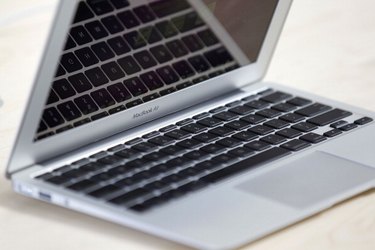
Apple's line of Mac computers are known for being fast and user-friendly, which makes it easy to stock your Mac full of photos, music, videos, documents and random files. While Macs don't have a reputation for crashing, they do have a reputation for getting sluggish when overloaded. Most Mac owners have gotten to know the dreaded spinning rainbow wheel, which appears when applications stall. Stalling can happen frequently when your Mac is working too hard. Cleaning up your Mac will help it run better and faster, while hopefully reducing your encounters with that pesky spinning wheel.
Step 1
Open your Activity Monitor to see which applications are hogging your RAM. Go to your "Applications" folder, then click "Utilities" and double-click the "Activity Monitor" icon to open. Click on the "System Memory" tab to see how much memory your open applications are using. Macs don't usually stall if you use multiple applications at the same time. However, if you notice a particular application taking up a lot of RAM, try using it after closing all of your other applications.
Video of the Day
Step 2
Eliminate startup menu items. Startup menu items are the applications that launch automatically when you log in to your computer and they can seriously slow down your Mac if you let them build up. Go to your "System Preferences" and click the "Accounts" panel. Click on "Login Items" and review your list. If you have more than three applications opening on login, remove the extras that you don't really need.
Step 3
Run a memory analysis program such as DaisyDisk or Disk Inventory X to find which files are taking up the most space. Daisy Disk costs $19.99 (as of February 2011) to buy but offers a free trial with full features and Disk Inventory X is free. Your Mac saves certain files, such as sent mail messages or caches, that you may not find by exploring your Finder. Memory analysis programs created a visual representation of what files and documents you have, how much space they are taking up and where they are located on your computer. Trash large files that you don't need.
Step 4
Use an uninstaller application. Macs use an easy "drag and drop" system for most application installations and to delete you just drag and drop them in the Trash. Some of these applications create folders in your library and caches that you may miss when throwing them our. Uninstaller applications, such as AppCleaner, remove the application and all of its related files and folders. AppCleaner is available for free download.
Step 5
Remove clutter from your desktop. Having a few files and folders on your desktop is fine, but your Mac creates separate windows for each desktop icon and a seriously cluttered desktop can really slow down your Mac. Group your desktop items in to folders to reduce the number of icons.
Step 6
Free up at least 20 percent of your hard drive space. Your Mac's RAM is more important than your hard drive space, but your Mac still uses part of your hard drive space to run large applications and tasks. Freeing up significant hard drive space will improve speed and performance on your Mac.
Step 7
Perform a full update. Keeping your software up to date is essential. Use "Software Update" to verify your Apple applications, firmware and security are up to date. Try a third party application, such as AppFresh, to manage updates for your other applications not managed by Software Update. AppFresh is available for free download.
Step 8
Restart your computer. Mac's don't have a tendency to crash that often so the need to restart is not always present. However, restarting your Mac gives your system a refresh. It is particularly effective to restart your Mac after having performed the previously mentioned disk cleanup steps.
Video of the Day